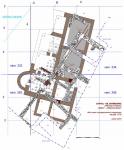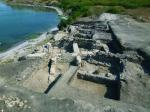Summary (English)
POROS (Milen Nikolov – m_kotlenski@abv.bg, Doroteya Giurdzhiiska) Several buildings were constructed at the end of the 5th – beginning of the 6th centuries AD over the remains of the Roman villa. Building South consisted of two rooms and was built in rubble masonry. The finds included coins: the earliest one of Justin I and the latest one of Heraclius minted in AD 620/621, a bronze medallion with enamel and images of crosses, a quern, fragmentary vessels: dishes, bowls, pitchers, pots, amphorae, including an amphora of the Carrot Type (spathea) dated to AD 550 – 630. Building North was built in rubble masonry. The collapsed roof-tiles were discovered and the finds beneath included a dolium, nails, sherds, a terracotta lamp, and coins: the earliest ones of Justin I and the latest ones being four folles of Heraclius and his son Constantine, one of them minted in AD 620/621. A wall built in rubble masonry belonging to Building A was discovered to the northwest of Building North. Building A was earlier than Building North and dated to the end of the 5th – beginning of the 6th centuries AD. Buildings South and North were synchronous and they probably were warehouses. The Roman villa was built at the end of the 2nd century AD and was abandoned during the AD 320s – 330s. It consisted of nine rooms and the western ones were with hypocaust flooring. An entrance was explored, probably the central one, flanked by pilasters built of bricks. The finds included coins of Antoninus Pius, Marcus Aurelius, Commodus and Septimius Severus.
- Milen Nikolov - Regional Museum – Burgas
- Doroteya Giurdzhiiska - Regional Museum – Burgas
Director
Team
Research Body
- Regional Museum – Burgas






![Download [PDF]](/excavation/skins/fasti/images/results/download_sml.png)
